
Lake Vostok is the largest of Antarctica's almost 400 known subglacial lakes. Lake Vostok is located at the southern Pole of Cold, beneath Russia's Vostok Station under the surface of the central East Antarctic Ice Sheet, which is at 3,488 m (11,444 ft) above mean sea level. The surface of this fresh water lake is approximately 4,000 m (13,100 ft) under the surface of the ice, which places it at approximately 500 m (1,600 ft) below sea level.
The Australian Antarctic Division (AAD) is a division of the Department of Climate Change, Energy, the Environment and Water. The Division undertakes science programs and research projects to contribute to an understanding of Antarctica and the Southern Ocean. It conducts and supports collaborative research programs with other Australian and international organisations, such as the Bureau of Meteorology and Geoscience Australia, as well as administering and maintaining a presence in Australian Antarctic and sub-Antarctic territories.

Casey Station, commonly called Casey, is one of three permanent stations and research outposts in Antarctica managed by the Australian Antarctic Division (AAD). Casey lies on the northern side of the Bailey Peninsula overlooking Vincennes Bay on the Budd Coast of Wilkes Land in the Australian Antarctic Territory, a territory claimed by Australia. Casey is 3,880 kilometres (2,410 mi) due south of Perth, Western Australia.

Davis Station, commonly called Davis, is one of three permanent bases and research outposts in Antarctica managed by the Australian Antarctic Division (AAD). Davis is situated on the coast of Cooperation Sea in Princess Elizabeth Land, Ingrid Christensen Coast in the Australian Antarctic Territory, a territory claimed by Australia. Davis lies in an Antarctic oasis, a mostly ice-free area known as the Vestfold Hills.
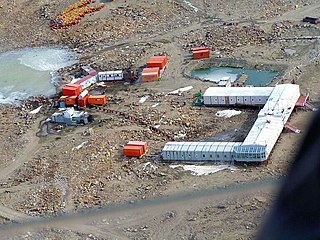
The Indian Antarctic Programme is a multi-disciplinary, multi-institutional programme under the control of the National Centre for Polar and Ocean Research, Ministry of Earth Sciences, Government of India. It was initiated in 1981 with the first Indian expedition to Antarctica. The programme gained global acceptance with India's signing of the Antarctic Treaty and subsequent construction of the Dakshin Gangotri Antarctic research base in 1983, superseded by the Maitri base from 1989. The newest base commissioned in 2012 is Bharati, constructed out of 134 shipping containers. Under the programme, atmospheric, biological, earth, chemical, and medical sciences are studied by India, which has carried out 40 scientific expeditions to the Antarctic.
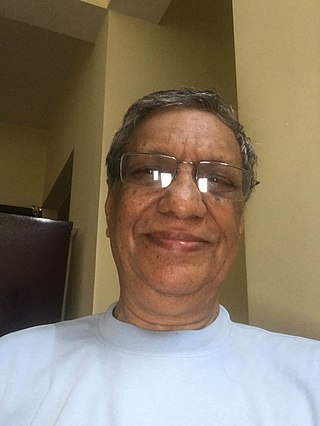
Prem Chand Pandey is an Indian space scientist, planetary scientist, and academic in the fields of satellite oceanography, remote sensing, atmospheric science, the Antarctic and climate change, and also he is the founding director of the National Centre for Polar and Ocean Research (NCPOR).

Emma Letitia Johnston is the Deputy Vice Chancellor (Research) at the University of Sydney. She was former, Dean of Science at the University of New South Wales and President of Science & Technology Australia. She is an authority in marine ecology and a former Pro Vice-Chancellor (Research) at UNSW.

Nerilie Abram is an Australian professor at the ANU Research School of Earth Sciences, Australian National University, Canberra, Australia. Her areas of expertise are in climate change and paleoclimatology, including the climate of Antarctica, the Indian Ocean Dipole, and impacts on the climate of Australia.

Leanne Armand was an Australian professor of marine science. She was an expert in the identification of diatoms in the Southern Ocean. She was known for her contributions to the understanding of past Southern Ocean dynamics and sea ice as a result of her knowledge of diatom distributions and ecology.
Ulrike Mathesius is a German–Australian plant microbiologist in the Division of Plant Sciences at Australian National University (ANU). She is an Australian Research Council (ARC) Future Fellow at the ANU, National Tertiary Education Union (NTEU) member and Professor at the ANU in plant science, biotechnology and plant-microbe interactions. Her research focuses on root microbe interactions and symbionts to parasites. Mathesius won the 2013 Fenner Medal awarded by the ARC for research in biology for outstanding early-career researchers under the age of 40.

In-Young Ahn is a South Korean scientist. She is known for being the first South Korean woman to visit Antarctica and the first Asian woman to become an Antarctic station leader. She is a benthic ecologist and is currently working as a principal research scientist for Korea Polar Research Institute.
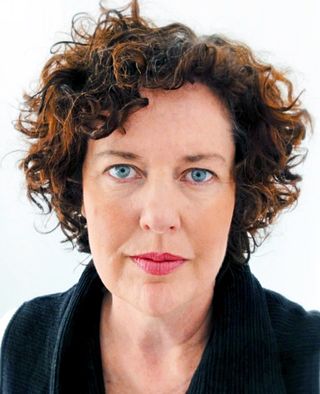
Dana Michelle Bergstrom is a senior researcher at the Australian Antarctic Division most notable for her work on identifying and mitigating risks against Antarctic and Sub Antarctic Ecosystems.

Jan Maree Strugnell is an Australian evolutionary molecular biologist. She is a professor and director in the Centre for Sustainable Tropical Fisheries and Aquaculture at James Cook University, Townsville, Australia. Strugnell's work has investigated population and species level molecular evolution in Antarctic and deep sea species in the context of past geological and climatic change. Strugnell's work also uses genetic tools to help solve bottlenecks in aquaculture and fisheries industries.
Kathleen Elizabeth Conlan is an Antarctic marine biologist who studies sea floor marine life. She was named one of Canada's greatest explorers by Canadian Geographic.

Justine Shaw is an Australian Antarctic researcher, best known for her conservation work on subantarctic islands, currently working at the Queensland University of Technology. She has a wide global research network, having worked in Australia, South Africa, sub-Antarctic/Antarctic and the Arctic.
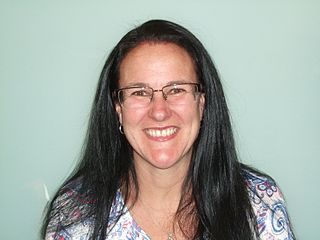
Catherine K. King is an Australian ecotoxicologist who studies sub-Antarctic and Antarctic regions, with a focus on climate change and the impacts of contaminants and environmental stressors in terrestrial and marine ecosystems.

Siti Aisah Binti Hj Alias is a Malaysian marine polar researcher and lecturer. As of August 2016, she is Associate Professor and Deputy Director of the National Antarctic Research Centre (NARC) in the Malaysian Antarctic Research Programme (MARP), at the University of Malaya. Her work focuses on the physiology of marine and polar microbes and fungi.

Gwen Fenton was the Chief Scientist of the Australian Antarctic Division and is the first woman to hold this position. She discovered that the fish species Hoplostethus atlanticus can live to over 100 years old, leading to significant changes to the management of the species.
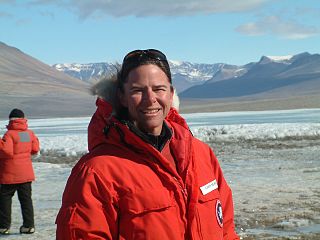
Alison Murray is an American microbial ecologist and Antarctic researcher, best known for studying the diversity, ecology and biogeography of Antarctic marine plankton dynamics of the plankton over the annual cycle; and her work demonstrating the existence of microbial life within an ice-sealed Antarctic lake. She studies how microorganisms persist and function in extremely cold and harsh environments, including those that lack oxygen and biological sources of energy.
Nicole Dubilier is a marine microbiologist and director of the Symbiosis Department at the Max Planck Institute for Marine Microbiology since 2013 and a Professor of Microbial Symbioses at the University of Bremen. She is a pioneer in ecological and evolutionary symbiotic relationships between sea animals and their microbial partners inhabiting environments that harbour low nutrient concentrations. She was responsible for the discovery of a new form of symbiosis between two kinds of bacteria and the marine oligochaete Olavius algarvensis.















